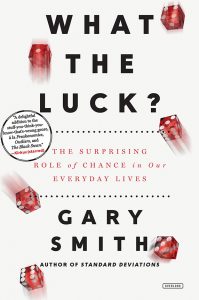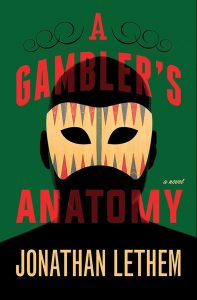 Professor Gary Smith Explains the Role of Chance in Everyday Life.
Professor Gary Smith Explains the Role of Chance in Everyday Life.
WHAT THE LUCK?
Why does your favorite team have an outstanding season and then struggle to replicate its previous success? You’ll look for all sorts of reasons, but it’s likely just a matter of chance.
According to Professor of Economics Gary Smith, we are hardwired to make sense of the world and underestimate the role of luck in our daily lives. In his new book, What the Luck? The Surprising Role of Chance in Our Everyday Lives, Smith argues that understanding the role of luck through the statistical concept of regression to the mean is the key to realizing that exceptional success is often transitory.
“Whenever there is uncertainty, there is regression. It happens in parenting, education, sports, medicine, business, investing and more. Don’t be misled by chance and surprised by regression,” says Smith.
Smith’s vision for the book began with an academic paper more than 20 years ago. He noticed that sports commentators tend to believe that outstanding performances will continue season after season. When they don’t, the commentators attribute the fall-off to laziness, a lack of focus or a sophomore slump. Along with Teddy Schall ’99, Smith showed that baseball performances regress, in that the top players in any season tend to do not as well the season before or the season after.
What the Luck? lies on two main pillars that explain why even the most skilled and talented will regress toward a norm or midpoint. For example, a student with the ability to average 80 percent on her tests, could score 90 percent on a “lucky” day or a 70 percent on an off day.
Second, of those students who do score 90, most were lucky and therefore won’t do as well on another test of the same material. They will regress. It is a mistake to conclude that the student with the highest score is the best student in the class, and it is a mistake to conclude that she didn’t study as hard when she gets a somewhat lower score on a second test.
According to Smith, the same principles can be applied to professional sports, medicine and investments. When a team wins a championship, we conclude that it is the best team and expect it to keep winning championships. When it does not repeat, we assume that it’s the team’s fault—when it may have been lucky to win in the first place. A doctor who sees a worrisome medical test result assumes the patient is sick and prescribes a treatment. When the patient improves, the doctor assumes that the treatment worked—when the patients may not have been ill in the first place. When a stock goes into the Dow Jones Industrial Average because it has been doing well, investors assume that it will keep doing well. When it doesn’t, investors attribute it to the Curse of the Dow, when the stock may have been lucky before it entered the Dow.
“If instead, we recognize that chance may play a role, we are less likely to overreact,” Smith says, “The champion is not necessarily the best team; the patient’s reading does not necessarily imply disease; and the companies entering the Dow are not necessarily the best investments.”
A prolific writer, Smith is the author of eight textbooks, three trade books, and 80 academic papers. His research interests are financial markets, especially the stock market, and the application of statistical analysis to finance and sports.
—Patricia Zurita
 Author/Professor Jonathan Lethem Discusses his Writing Process.
Author/Professor Jonathan Lethem Discusses his Writing Process.
HIGH-STAKES WRITING
Bestselling author Professor Jonathan Lethem’s new novel, A Gambler’s Anatomy, is the story of a James Bond-esque international backgammon hustler who believes he is psychic but is sideswiped by the discovery of a tumor in his face. He is then forced to grapple with existential questions, like: Are gamblers being played by life? What if you’re telepathic, but it doesn’t do you any good?
Which raises another question: Why did Lethem, a critically acclaimed novelist and essayist, choose to write about backgammon and gambling?
“I always lean forward when someone in a story or a movie goes to the casino or steps up to the pool table or goes to the online poker game. So, I began by thinking in the simplest way, ‘I want to do that. I want to write a gambling story,’” says Lethem.
Given the high stakes, gambling serves as a rich metaphor for life, he says. “The backgammon board or any kind of gambling arena is a kind of microcosmic world, it intensifies your relationship to life. But it’s also an escape; it’s a bubble you go into; it’s outside of life. While you’re there, everything else disappears,” he says.
And ultimately, life—the house—always wins, he says.
Lethem, whose nine previous books include Motherless Brooklyn and The Fortress of Solitude, is known for his genre mixing and experimentation. He says this book is a more deliberate engagement with genre, classifying A Gambler’s Anatomy as a horror novel, though it doesn’t have the traditional scares. Lethem says he wanted to write a book where the reader can’t take his or her eyes off of the character’s nightmarish descent, which is set in Berlin, Singapore and Berkeley.
Lethem’s writing process starts with what he calls “blundering around” and moves to dogged intention. Once he finds a voice that he likes, he works every day. But he says he is not concerned with hours or pages, so as much as with touching the project consistently. When Lethem gets stopped at a crossroads, he says, he will just sit there “staring at the page and tolerating the anxiety.” While so many other writers toss out lots of material and create alternate scenes that don’t end up in their books, Lethem treads carefully. “I try not to put a foot wrong. People sometimes ask you afterwards for the outtakes, asking, ‘Could we publish the deleted scenes?’ And I say, ‘I’m sorry, I don’t really generate those.’ If I’m turning in the wrong direction and it doesn’t please me to write in that mode, I’d rather sit and wait,” he says.
Born into a creative family, as a child Lethem thought about becoming a painter like his father, or a filmmaker or cartoonist. But his mother gave him a typewriter, “which was like ‘Go,’” he says. By the age of 14, the voracious reader announced he wanted to be a writer. His enjoyment of the craft hasn’t dimmed.
“When you begin to break down all the variations that are possible and all the implications of the decisions you’re making at a preconscious level when you write sentences, even in that very basic mode, you can never stop being fascinated by it. I like trying to stay an apprentice to the task.”
Lethem, the College’s Roy E. Disney Professor of Creative Writing, says he finds conversations in the classroom stimulating. “Seeing people trying to enact what they’re dreaming up, what they want to get on the page—trying to close that distance between what you visualize or what you hope your reader will experience and what actually lands on the page—is a very rich and very mysterious area of instability,” Lethem says.
—Sneha Abraham
 Professor Char Miller Looks Below the Surface of California’s Ecological History.
Professor Char Miller Looks Below the Surface of California’s Ecological History.
NOT-SO-GOLDEN HISTORY
Professor Char Miller’s new book, Not So Golden State: Sustainability vs. the California Dream, is a collection of essays that examine California’s complex and sometimes contentious relationship between nature and humans.
Inspired by his many travels across California’s varied landscapes, and with chapters like “PetroLA,” “Razed Expectations,” and “Strawberry Fields Forever” among others, Miller’s essays give the reader a look into the effects that local, state and federal policies (both good and bad) have had on the natural environment, the impact of recreation on national forests, parks, wildlife and nature refuges, and current efforts to restore what California has lost or is losing.
Covering everything from water politics to wild fires riverbeds and sage and chaparral, Miller nudges the reader to look at the Golden State through a different lens, and Miller hopes, inspire readers to look at, treat and integrate with nature in ways that are beneficial to both humans and the natural environment. In “Razed Expectations,” Miller excoriates the U.S. Army of Engineers for gutting the Sepulveda Basin and the ensuing devastation left on the terrain. In “Water Fights,” he looks at the current battle the city of Claremont is waging to gain local control over water and in “Lesson Learned,” Miller looks at the politicization of wild fires and the cautionary insights gained and soon forgotten from the 2009 Station Fire that burned 160,000 acres of the Angeles National Forest.
“I hope that people reading this start to think about our relationship to nature – and it to us. How do we protect natural habitats, animals, resources, from us?”
“The central argument of the book is that we have agency within the larger world but our actions must be consistent with systems we have to protect the natural environment. The book is an effort to give people a roadmap to act with a kind of grace.”
On field trips with students, and hikes and travels with his wife and on his own, Miller says he gets curious about why things are the way they are and looks to the past to find answers: “My writing is sparked by encounters with a particular place and time in nature that led to thinking about that space in the past.”
A prolific writer, Miller regularly publishes op-eds, blog entries and books on the West and its environmental history.
“Writing is a way of inscribing myself in the landscape and helps make the landscape comprehensible.”
Miller sees his latest book as the end to a trilogy, of sorts, of two earlier collections of essays that are framed by his own westward journey that started out in San Antonio, Texas and takes him through Arizona and ultimately to Claremont, California.
“With Deep in the Heart of San Antonio: Land and Life in South Texas, I am figuring out what’s going on, and On The Edge: Water, Immigration, and Politics in the Southwest is a transitional book that takes me from San Antonio to California. Not So Golden State centers on California but looks east and raises the question about a new world, of where we’re going.”
—Carla Guerrero ’06
